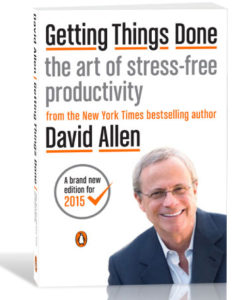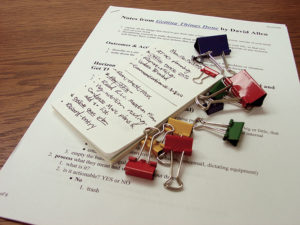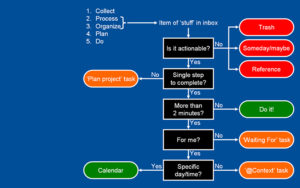If you liked our last blog, on the Bullet Journals, but wanted something a bit more in-depth, here is the next installment of our productivity blogs. This one is everything you need to know about Getting Things Done.
Getting Things Done
Getting Things Done is a book by David Allen, detailing the time management method. It was originally released in 2001, but had a 2015 re-release, focusing more on the digital age!
GTD is a similar method to the bullet journal. It’s all about time management, organising your to-do list into priorities and just making your workflow more effective. It’s aim is for you to be clear in what your goals are, achieving them, and keeping clutter and unimportant tasks out of mind until you’re free to focus on them.

Like the bullet journal, the Getting Things Done method asks you to spend time each week reviewing what you did previously, what you want to accomplish in the week coming, breaking each task down into manageable items and then moving forward with them.
However, while the bullet journal is totally analogue and pen-on-paper, GTD can be used with any to-do, reminder or calendar app you already use. All it takes is you changing how you use it!
GTD isn’t perfectly clear cut, it is a guide for you to follow and adjust according to your own preferences and flow, but using it can make you more aware of how and when to do what you need to do. Getting Things Done breaks down into five steps to capture, clarify, organise, reflect and engage with the actions on your to-do list and get more out of your day. It’s all about putting in that little bit of work at the start of your day so you can make the most of it later on.

So, if you want to use the GTD method, here’s how you get started!
1 – Capture: This is basically where you jot down (on paper, in your planner or to-do apps, whichever you prefer!) your to-dos, tasks you need to do, ideas, goals, everything you need to do, have it written down somewhere. Whatever you’re using to mark things down in should be easy to get to and use. Don’t think “I must remember to write that down later!” No. Write it now before you forget, and then it’s somewhere you can access when you need to do it.
2 – Clarify: Be specific in what you need to do. Don’t write a one or two word item that will confuse you when you look back on it a few days later. Make sure you know exactly what each item means and needs. And then, break it down into actionable steps. If it’s too broad or vague, you won’t know where to start. And if there’s any items you can pass along or delegate, then do it. Don’t waste time trying to decide if you can maybe squeeze that in today, if it’s too much, pass it along, or move it to the next day.
3 – Organise: Put the items in order of priority. This way you can get important things done fast, and less important things aren’t sitting at the top of your list. At this point, you shouldn’t have started anything on your list, you’re just making sure they’re all in the right places.
4 – Reflect: Look back over your list. See what your first actions of the day should be, make sure nothing on the list is too vague. This is something that should be done multiple times a day. You want to make sure you’re progressing and that your list in is line with your priorities, which are subject to change. If you’ve clarified your items properly, reflecting and understanding will really pay off.
5 – Engage: Get to it! Pick your action, and get things done! Now that you’ve collected, organised and clarified your actions correctly, you know what tasks need doing. You’re ready to get things done. There’s a flowchart in the book about which items to work on straight away, and which to postpone which could be quite helpful.
These are just the basics, and how you chose to prioritise and engage will be entirely up to you. What’s important is that you know what needs to be done, and what doesn’t. Even small things you want to get done should be on the list, but low down, so you know that while they need doing, there are other things that need doing first.
There are lots of ways to incorporate your work email into this method! Using different folders can be a way to capture and clarify at the same time.
And, if you’ve done everything to this point but are unsure what needs doing next, GTD has a handy flowchart so you can start and keep up momentum!

It may seem complicated, but really the aim of this, and the bullet journal, is to spend a small amount of time organising your tasks and goal. And this means less time stressing or time spent on things that aren’t a high priority.
If you want more information on Getting Things Done, check out the website! Or buy the book from Amazon.co.uk.
So, what do you think? Would you incorporate this method into your work? Or would you use it in conjunction with your bullet journal? Let us know!

